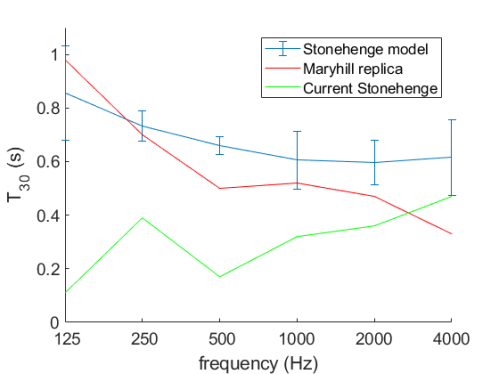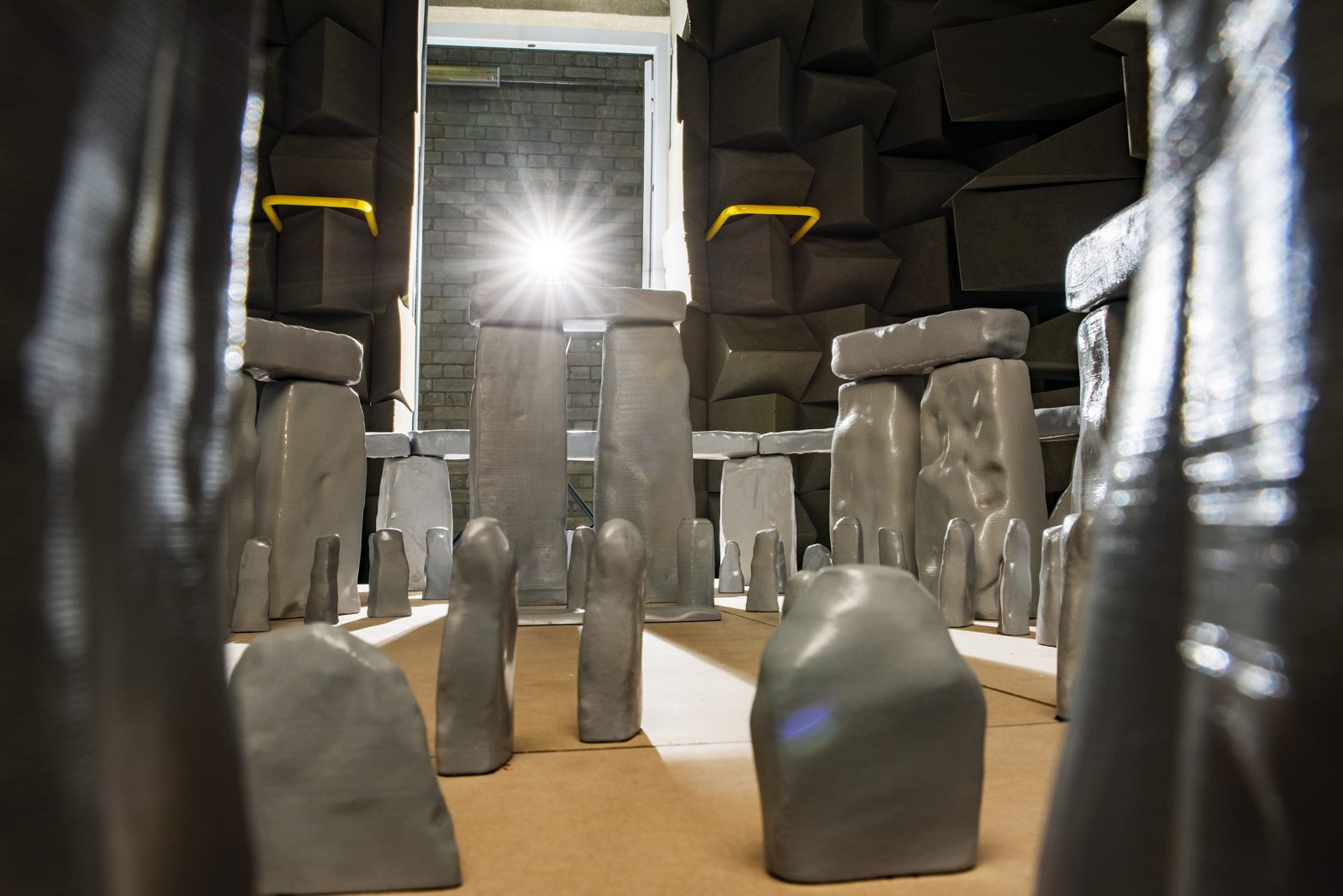More on the modelling work can be found in the open access paper in Journal of Archaeological Science. Or the blogs below:
- Making an acoustic scale model of Stonehenge
- How we measured the acoustic scale model
- How reverberant was Stonehenge?
- Beyond reverberation time
- Was there a whispering gallery effect?
- Were there discrete echoes?
- Acoustics of Stonehenge and speech
FAQ
What questions are you trying to answer about Stonehenge and why?
The main research question is to quantify the acoustic condition of Stonehenge in it’s historic configurations and work out the likely effect of the acoustic on listeners.
Human ceremonies involve sound, whether that is music or speech. I hope to understand whether Stonehenge’s acoustics would have aided ceremonies through providing reflections to amplify speech and embellish music. I’d also like to clarify whether there was any other extraordinary acoustic effects in the circle.
Do you believe Stonehenge was built for acoustic reasons?
This isn’t something that my research aims to answer. I’m an acoustic expert applying my knowledge of physics and sound perception to better understand the conditions at Stonehenge past. (Personally, I think it is very unlikely that the circle configuration was about achieving some acoustic, but that is just my opinion, whereas the modelling I do is based on scientific evidence.)
Why scale modelling?
It’s a well-establishd method in Architectural Acoustics. It used to be the default method for testing performance venues before they were built. Nowadays, computer modelling is more popular, but the industrial-standard algorithms are poorly suited to modelling stone circles.
Why do you test at 12 times the frequency?
We need the sound waves in the model to interact with the stones in the same way as at real Stonehenge. The way sound reflects and bends around the stones depends on the relative size of the sound waves and the stones. By testing at 12 times the frequency, the sound wavelength is a twelth of the size, so the interaction with the stones ( the diffraction) is properly modelled.
Most of the results I’m currently presenting are for the frequency range 90 Hz to 5,600 Hz full-scale. But in the model we test at 12 times that frequency range, about 1,000 Hz to 67,000 Hz.
Shouldn’t your model be made of stone to match the original site? Plus grass or mud for the floor?
What is important is to match the acoustic properties of the model to the real site. That doesn’t require the materials to be the same, but they do need to react to sound waves in a similar way. In terms of materials, the key property to match is the absorption coefficient: how much energy is absorbed everytime sound reflects from the material.
This match in acoustic properties needs to account for the higher frequency in the model testing. If we take the orchestral tuning A in real Stonehenge (440 Hz), in the model this is actually tested at 440×12 = 5,280 Hz. So we require the acoustic properties of the floor in real Stonehenge at 440 Hz to be the same as the acoustic properties of the floor in the model at 5,280 Hz. If the model was on mud or grass, it would be far too absorbing.
I’ve assumed that the floor of Stonehenge has the absorption coefficient of compacted grassland/gravel. With all the people moving huge stones around, it’s likely to be compacted! At 440 Hz this sort of compacted ground would absorb about 5- 15% of the sound energy on each reflection. According to [1] unvarnished MDF absorbs 12% of the sound energy at the model scale frequency. This is why the model is on unvarnished boards.
For the stones, the aim in the modelling was to make them as non-absorbing as possible. The real stones only absorb 1-2% of sound on each reflection. Stone would have been fine, but it would have been impossible to make with the accurate shapes. A combination of 3D printing and moulding of plaster-polymer was used. They were painted to seal any pores to minimise absorption.
How come you’re testing the model indoors, won’t that cause problems?
The test room at Salford Uni is a semi-anechoic chamber. The grey wedges are highly absorbing. This means once sound has left the circle it gets absorbed by the test chamber walls. This is the same as would have happened at real Stonehenge, where sound going between the outer sarsens just disappears into the countryside.
Why not test the real Stonehenge?
The current Stonehenge has too many stones missing or lying on the floor. The acoustic conditions are very different to what Stonehenge would have sounded like when all the stones were present. Below is a measurement of reverberation time in the current Stonehenge compared to the 1:12 scale model from one of my blogs. Except at the highest frequency measured, the reverberation times are very different because of the missing and displaced stones.

Aren’t you repeating previous work, Fazenda and Till measured the Maryhill concrete replica in the USA?
The Maryhill concrete replica doesn’t have exactly the right geometry. As the photos below show the concrete stones in Maryhill are too perfectly rectangular. Also, archaeologists now think there were probably more bluestones as well [2]. This changes the acoustics.

Any other questions?
Feel free to ask more questions in the comment section below
References and notes
[1] Jeon, J.Y., Ryu, J.K., Kim, Y.H. and Sato, S.I., 2009. Influence of absorption properties of materials on the accuracy of simulated acoustical measures in 1: 10 scale model test. Applied acoustics, 70(4), pp.615-625.
[2] Darvill, T., Marshall, P., Pearson, M.P. and Wainwright, G., 2012. Stonehenge remodelled. Antiquity, 86(334), pp.1021-1040.
Follow me
4 responses to “Stonehenge”
I’m looking for an audio file that illustrates what the sounds you tested (voices, flutes, horns drums) may have been like—transposed of course to their natural frequencies. Have you produced such a file?
Good idea. I used to have some examples on the site, will sort some time
Fascinating stuff.
Any joy with recreating possible soundscapes of past millennial ceremonies?
Hello Mr Cox,
after seeing the BBC video about your scale model, it occurred to me how effective Stonehenge would have been for amplifying the sound of people chanting. Not only if they were inside the circle, but especially if people were standing the gaps and facing inward, singing or chanting. I would expect the sound would build and perhaps carry upward, since the gaps would be lessened by the presence of people absorbing (and further reflecting if they were holding objects like wood or shields). It makes me think it’s a good way for ancient peoples to send chanting or messages skyward, toward the sun, which was so important a symbol to them. Anyone standing on the top level of the circle would hear the sound travelling upward, and could also add their voices to it, possibly believing all the voices were being pulled skyward. Thank you for your work. Very interesting to me, a sound artist and editor who works primarily with voices. Dale Sheldrake, Canada.